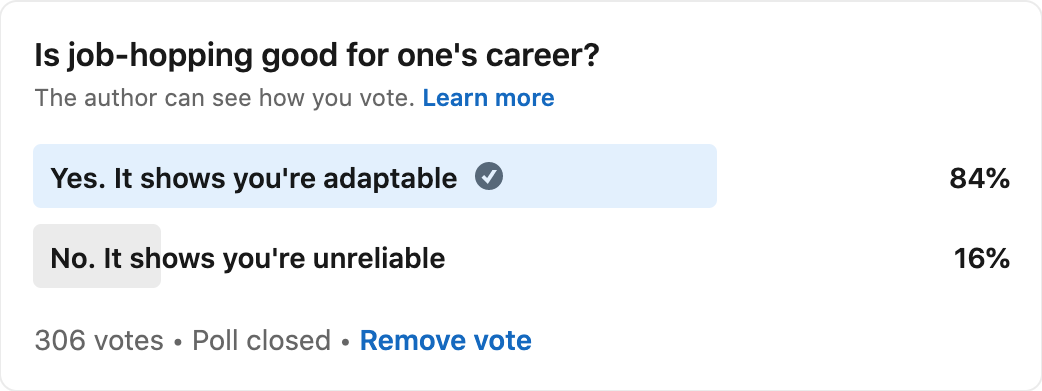Since the concept of “a job for life” or even “a career for life” doesn’t seem to exist any longer, some feel that job-hopping is acceptable and could actually increase an individual’s agility and adaptability, making them better employees. In fact, some employers see those who switch job every 2 to 3 years as great candidates. But how do employers who want to avoid having to constantly train new employees feel? What should they do to nurture and retain the talent they want?

Job-hopping is no longer as frowned upon as it was a few years ago.
In the past, job candidates who switched jobs every 2 years or even more frequently were often disregarded by prospective employers. They were seen as being flaky, unreliable, uncommitted and possibly incompetent.
These perceptions have long disappeared.
The current crisis has brought into sharper focus the fact that there is no such thing as a “job for life.” Considering this, more employers are starting to see job-hopping as merely employees’ way of cultivating career longevity. Moving every few years is likely to expose them to more growth opportunities in terms of broadening their skillsets and even expanding their network. This enables them to be more resilient workers.
Job-hoppers could actually be great assets to employers. Having to adjust to a new job every few years builds agility. Many job-hoppers realise the importance of achieving results and making a mark before moving on to the next job. As such, they have to learn new things and become competent at a job more quickly than others. Employers are starting to see that these qualities make job-hoppers better employees in the context of a fast-changing business landscape. In fact, 84 per cent of respondents to our recent LinkedIn poll on this subject said they believe job-hopping is a reflection of adaptability.

Results of PeopleSearch’s recent LinkedIn poll.
WHAT ABOUT TRAINING COSTS AND TALENT RETENTION?
But where does all of this leave employers who don’t want to have to constantly train new employees? And where does it leave those who don’t want to lose top talent?
In regard to training, we advise doing a cost-benefit analysis. If the job-hoppers you hire tend to perform well and make a positive impact on your business within a short period of time, you might find yourself better off than if you merely hung on to employees who’ve fallen into a comfort zone and stagnated.
When it comes to retaining high-performing individuals, employers need to go back to the basics.
Top performers are not likely to stay with employers who don’t provide them with opportunities to continually learn and advance in their careers. Companies must have serious conversations with those they want to retain. Put yourself in the individual’s shoes. What would give them a sense of career growth and stability?
Many candidates say they don’t mind staying with an employer as long as they are given opportunities to grow their skillsets, deepen their experience and expand their network within the company. This not only increases job satisfaction, but also ensures that in case circumstances make it necessary for them to leave one day, their varied skills and experiences would make them marketable to a different employer.
In light of this, here are some constructive steps employers can take.
Promote from Within
Promoting from within not only provides employees with a clear path to increased responsibility and remuneration, but also makes them feel valued as an integral part of the company’s success. They are more likely to stay with you as a result.
Promotions will also serve to burnish their CVs should they ever need to move in the future. They will be grateful to you for providing them with opportunities that help them in this regard as well.
Invest in Talent Development
Investing both time and money in continual education and training shows employees you value their growth. Aside from subsidising external training courses and providing in-house training, have regular conversations with each individual to jointly chart an education and skills training path, taking into account their aptitudes and interests.
Provide Opportunities for Stretch Assignments and Cross-skilling
Provide opportunities for them to cross-skill by deploying them to other vital departments. This allows employees to develop proficiencies outside of their current scope of work. They learn new skills, hone a different area of expertise and grow their network.
Stretch them by providing new challenges periodically so that they learn, grow and feel engaged. This also shows them that you believe in their capabilities.
In addition, continual growth will prepare them for employment beyond your organisation, should the need arise.
Offer Benefits They Actually Want
Benefits play an important role in employee engagement. Go beyond the usual healthcare coverage and paid medical leave. Instead, offer stock options or other financial rewards to top performers who stay.
Some might prefer flexible work schedules or the opportunity to work mostly remotely.
Tailor your benefits to the individual.
Make Sure Your Efforts are Ongoing
Most importantly, don’t wait till they say they want to leave or till you hear rumblings of their imminent departure. Retention is an ongoing process. Once you’ve identified individuals who are worth the extra investment, don’t hesitate to kick things into high gear.




Leave A Reply